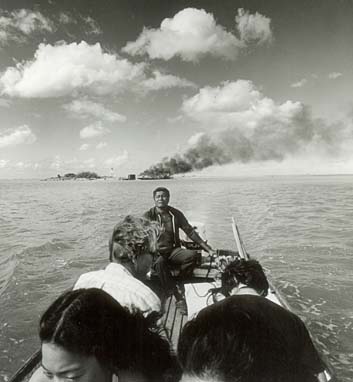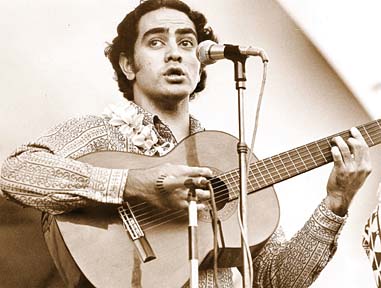
COURTESY ED GREEVY
Hawaiian nationalist Kalani Ohelo speaks at a 1971 Save Our Surf-Kokua Hawai'i demonstration against evictions in Kalama Valley. The "Huli" sign conveys the group's position: to overturn the system. An upheld poi pounder symbolizes resistance to cultural displacement.
Images of unrest
Ed Greevy has documented the
struggle for Hawaiian rights
and communities resisting
development in a way few
have done: through the lens
of a camera. A lifetime of work
is on display through Sunday.
Handbag tucked neatly in the crook of her arm, a demure elderly woman rests her umbrella against the sidewalk.
She could be waiting for the bus -- but for the sign gripped in her other hand that reads, "Stop Eviction." Her gaze, weary yet hopeful, emanates from this picture taken by photojournalist Ed Greevy.
COURTESY ED GREEVY
Photographer Ed Greevy.'Ku'e:
For People, Land and Sea':On view: Through Sunday
Place: Academy of Arts Center at Linekona
Hours: 10 a.m. to 4:30 p.m. through Saturday and 1 to 5 p.m. Sunday
Admission: Free
Call: 532-8742
Spanning more than three decades of political activism in Hawaii, an exhibition of Greevy's work -- "Ku'e: For People, Land and Sea" -- is a bittersweet portrait of communities in the throes of social change. The exhibit runs through Sunday at the Academy of Arts Center at Linekona.
"Any photojournalist can record a scene, but what makes Ed's work stand apart is its resonance and poetry," says Academy of Arts Center curator Carol Khewhok.
At the artist's reception last month, the hero of the moment was a portly man in glasses whose genial smile barely cleared the leis heaped around his neck. When well-wishers trapped him on the wrong end of the camera, Greevy uneasily obliged: "Now I know what I subjected people to all these years."
The Los Angeles-born Greevy moved to Hawaii in 1967 after a stint in a New York insurance firm and another in advertising photography. His first foray into photojournalism came in 1970 when he documented Save Our Surf's efforts to protect Oahu surf spots from development.
"I went out of curiosity, and my political understanding began to awaken," says Greevy, who majored in political science in college.
SOS spawned the environmental movement in Hawaii with its grass-roots campaign, soldiered primarily by young surfers. The impact of Greevy's photos -- used in the group's slide shows, leaflets and posters -- drove the message home.
Public uprisings against development and dispossession of communities were occurring on every island, and Greevy could always be found at rallies, protest marches, fund-raisers and evictions.
COURTESY ED GREEVY
Terry Lee Keko'olani, an activist who came to leadership in the early '70s, speaks at a Save Our Surf demonstration at Sandy Beach in 1973. She would go on to participate in the occupation of Kahoolawe to protest the military practice bombing of the island.
The image of Heeia resident Epipania Estioko serenely wielding her umbrella and sign was taken at the state Capitol when 2,000 residents from affected communities gathered to demand that lawmakers regulate the building frenzy.
"Through Ed's pictures, we see the human agony that was created by the state, the counties and developers after statehood to transform Hawaii into nothing but a tourist spot," writes Hawaiian poet and scholar Haunani-Kay Trask in the captions accompanying Greevy's exhibit.
GREEVY AND Trask selected the photos for the exhibit -- no easy task, given the roughly 60,000 photographs he has shot since 1970. The two met in 1978 when both were helping 100 Sand Island fishing families resist eviction. Labeled as "squatters" in the news media, "they were asserting their right to live on the shoreline and to fish," Greevy recalls.
Trask notes that the Hawaiian sovereignty movement was birthed with the help of Greevy's photography. He describes how the families "were expressing their culture and Hawaiian nationalist sentiments. Hawaiian flags were all over the place, flown upside down."
"These are the images that historians 100 years from now will want," Trask says, "not those thousands of pictures of beautiful volcanoes that romanticize and mythologize Hawaii. These are people in extreme conditions. They're going to be evicted, their houses are going to be smashed. But (Ed) was always respectful, very unobtrusive in photographing them as human beings in their resistance and, in many cases, their defeat."
GREEVY FOUND inspiration in the work of the late Life magazine photographer William Eugene Smith, whose stark, moving photographs alerted the world to the plight of the Japanese fishing families poisoned by toxins dumped into Minamata Bay.
COURTESY ED GREEVY
Epipania Estioko wields an umbrella and a sign at the state Capitol during a protest against overdevelopment.
In the same light, Greevy put a human face to the tragedy of dispossession in a place known as Paradise, evoking the unadorned dignity and courage of those whom he calls "regular folks" -- farmers, fishermen, retired plantation laborers, homeless islanders.
"A lot of people who are poor, other than their high school or wedding (pictures), they never get professionally photographed," Greevy says. "So they'd often go, 'Wow, is that what I really look like?' That's gratifying for me, that I can bring that feeling of pride to them: 'Someone thought I was important enough to photograph.' "
Greevy himself lived for years in his darkroom to keep his overhead low. He shot in black and white because it was cheaper. After he wed a Kamehameha classmate of Trask's and had a son, Ho'ala, Greevy went the pragmatic route and took a steady job as an insurance claims analyst.
But he never forgot his real work. In 1993 he documented the gathering of 11,000 Hawaiians during the centennial observance of the overthrow of the Hawaiian government. More recently, he followed the military's bombing of Makua Valley and local protests against the U.S. invasion of Iraq.
COURTESY ED GREEVY
Mokauea resident Bill Molale leaves a burning house on Mokauea island, off the coast of Honolulu, in 1976. State contractors set the fire, intending to evict residents who had created a fishing village on the island.
"My camera is a tool I use to advance political beliefs that I hold," Greevy says.
Khewhok says she "felt it was very important to show Ed's work, because it resonates with right now."
"It's a reminder that you can't just sit back. If you don't like what's going on, you need to stand up for your views, as dangerous as that might be."
His images are on the cusp of greater exposure. In December they will be among those representing the 50 states in the "Only Skin Deep" exhibit at the prestigious International Center for Photography in New York City. A publisher has broached the possibility of a book project featuring a larger sampling of Greevy's work and Trask's writing.
The June 16 reception for "Ku'e" served as something of a reunion for activists who took part in the community struggles depicted in the photographs lining the hall. Young exhibit-goers stared, transfixed, at scenes of a history they never knew; some of the communities in the photos no longer even exist. But through the potent witnessing eye of Greevy's lenses, their impassioned struggles live on.
COURTESY ED GREEVY
George Helm, founder of Protect Kaho'olawe 'Ohana, plays the Waikiki Shell at a 1972 fund-raiser for Kokua Hawai'i.
When only a few friends and family members remained, plastic cups of juice were raised, as Trask toasted, "To my friend and comrade and Hawaii's greatest photographer."
Josephine Patacsil stood under the justice-seeking gaze of her late mother, Epipania Estioko -- the old woman in the "stop eviction" photo -- and softly added, "Mahalo, Ed, for capturing our history."
Naomi Sodetani is a Honolulu-based writer and independent documentary producer who focuses on arts, cultural, social and political issues.
Click for online
calendars and events.






